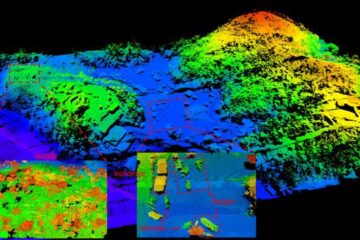Manifestation of quantum distance in flat band materials
(Left) The kagome lattice structure in real space. (Right) The corresponding band structure in momentum space. The bottom band is the flat band which exhibits anomalous Landau level spectrum. Credit: IBS
The geometry of an object indicates its shape or the relationship of its parts to each other. Did you know that the electrons in solids also have geometric structures?
In quantum mechanics, an electron in solids takes the form of a wave with periodicity so that the periodic electronic state, so-called the Bloch state, can be characterized by specifying its energy and crystal momentum which is proportional to its wave number.
The relationship between the energy and the crystal momentum of electrons is called the band structure of solids. For electrons in solids, the Berry curvature and the quantum metric of Bloch states take the role of the curvature and the distance of an object in geometry.
In fact, the geometry of quantum states is one of the central concepts underlying diverse physical phenomena, ranging from the celebrated Aharonov-Bohm effect to the topological phases of matter developed more recently.
For instance, the local Berry curvature is responsible for the anomalous Hall transport while its integral over a two-dimensional closed manifold gives the Chern number, an integer number describing the quantized Hall conductivity.
However, compared to the physics of the Berry curvature, the effects of the quantum metric on physical phenomena are less understood, especially in solids, although there are several recent works proposing the physical observables related to the quantum metric. Especially, there has been no clear guideline for searching materials in which the physical properties related with the quantum metric can be observed.
Prof. YANG Bohm-Jung and Dr. RHIM Jun-Won at the Center for Correlated Electron Systems within the Institute for Basic Science (IBS) in Seoul National University, Seoul, South Korea, and Dr. KIM Kyoo at the Korea Atomic Energy Research Institute, Daejeon, South Korea, reported that they found a way to measure the quantum distance of Bloch states in solids by applying magnetic field.
More specifically, the researchers have examined the energy spectrum under magnetic field, called the Landau level spectrum, of flat bands in the kagome and checkerboard lattices, and observed anomalous Landau level spreading arising from the flat band. Surprisingly, they found that the total energy spreading of the flat band's Landau level is solely determined by the maximum quantum distance between the Bloch states of the flat band.
Namely, the quantum distance of the Bloch states in solid can be measured by applying magnetic field to two-dimensional materials with flat bands!
Recently, two-dimensional materials with flat bands have received a great attention as a new platform to realize intriguing electronic states. A flat band indicates an electronic band structure in which the energy does not change when crystal momentum is varied. Such intriguing flat band structures appear in various two-dimensional lattices including the kagome lattice, checkerboard lattice, etc.
The theory group of the IBS CCES research team realized that, in many of the flat band systems, the Berry curvature of the Bloch states is zero due to the symmetry of the lattice. If the Berry curvature is strictly zero, one can naturally expect that the geometry of the Bloch states is solely determined by the quantum metric.
This interesting aspect motivated the IBS theory team to seriously consider two-dimensional materials with flat bands as a promising playground to study physical properties related to the quantum metric.
In fact, the semiclassical quantization rule predicts that an ordinary parabolic band under magnetic field forms equally-spaced discrete Landau levels, and the energy difference between neighboring Landau levels is inversely proportional to the effective mass of the electrons. When applied to a flat band with an infinite effective mass, the semiclassical theory predicts zero Landau level spacing so that a flat band remains inert under magnetic field.
In this study, the researchers observed a quite peculiar nature of the Landau level spectrum that is in sharp contrast to the conventional norm. They reported that the Landau levels of the flat bands spread into the empty region of the energy space where no electronic states are available in the absence of magnetic field.
The researchers found that the key to such an unusual Landau level spectrum is the fact that the flat band in the kagome and checkerboard lattices is crossing with another parabolic band at a point. The singularity in the wave function of the flat band arising from the band crossing point induces nontrivial geometric effect related to the quantum distance of the wave function, which in turn induces anomalous Landau level spectrum.
The first author, Dr. RHIM Jun-Won states, “Understanding the role of the band crossing in flat bands was the key to describe the anomalous Landau levels. This finding provides a practical way to unambiguously extract the quantum distance in solids.”
This study shows that the quantum distance or quantum metric can also play crucial roles in determining material properties as the Berry curvature does. Contrary to the previous works, this study clearly identified the candidate lattice systems in which the quantum metric effect is maximized while the Berry curvature effect is minimized, and discovered a way to directly extract the quantum distance in solids for the first time.
Considering the tremendous impact of the concept of the Berry curvature on the understanding the properties of solids, it is natural to expect that this study may facilitate the future study about the geometric properties of solids related to the quantum metric and the search of materials in which the related physical responses can be observed.
Prof. YANG Bohm-Jung explains that “This result would provide a critical step towards the complete understanding of geometrical properties of quantum states in solids. As there are many two-dimensional lattice structures hosting flat bands, our study may trigger future research activities for discovering novel geometrical phenomena related to the quantum metric in various condensed matter materials.”
Media Contact
More Information:
http://dx.doi.org/10.1038/s41586-020-2540-1All latest news from the category: Physics and Astronomy
This area deals with the fundamental laws and building blocks of nature and how they interact, the properties and the behavior of matter, and research into space and time and their structures.
innovations-report provides in-depth reports and articles on subjects such as astrophysics, laser technologies, nuclear, quantum, particle and solid-state physics, nanotechnologies, planetary research and findings (Mars, Venus) and developments related to the Hubble Telescope.
Newest articles

A universal framework for spatial biology
SpatialData is a freely accessible tool to unify and integrate data from different omics technologies accounting for spatial information, which can provide holistic insights into health and disease. Biological processes…

How complex biological processes arise
A $20 million grant from the U.S. National Science Foundation (NSF) will support the establishment and operation of the National Synthesis Center for Emergence in the Molecular and Cellular Sciences (NCEMS) at…

Airborne single-photon lidar system achieves high-resolution 3D imaging
Compact, low-power system opens doors for photon-efficient drone and satellite-based environmental monitoring and mapping. Researchers have developed a compact and lightweight single-photon airborne lidar system that can acquire high-resolution 3D…





















